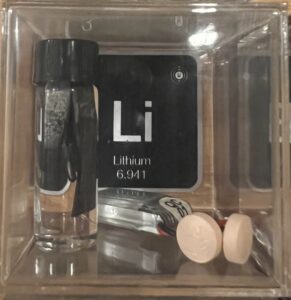Lithium
Atomic Number: 3
Atomic Mass: 6.941 u

In the world of elements, lithium stands out for its unique properties and wide-ranging applications. It’s not just another element on the periodic table; it’s a cornerstone in modern technology and medicine. Let’s explore the world of lithium, its characteristics, and the pivotal roles it plays in our everyday lives.
Understanding Lithium
Lithium, with the symbol ‘Li’, is the third element on the periodic table and is categorized under the alkali metal group. It’s incredibly light, so much so that it’s the lightest metal and the least dense solid element under standard conditions. This soft, silvery-white metal has an atomic number of 3, placing it right after hydrogen and helium in terms of lightness.
Powering the Future: Lithium in Batteries
One of lithium’s most groundbreaking applications is in the field of energy storage – lithium-ion batteries. These batteries power a vast array of modern technology, from smartphones and laptops to electric vehicles (EVs) and renewable energy storage systems. The reason for lithium’s popularity in batteries comes down to its high electrochemical potential, offering a superior energy-to-weight ratio compared to other metals. This means more power with less weight, making it ideal for portable electronics and crucial in the push towards greener transportation options like EVs.
Medicinal Marvel: Lithium in Mental Health
Lithium carbonate, a chemical compound of lithium, has been a mainstay in the treatment of bipolar disorder for decades. It’s known to help stabilize mood swings and is often a first-line treatment for this condition. The exact mechanism by which lithium impacts mood disorders is still a subject of research, but its efficacy in managing symptoms of bipolar disorder and reducing the risk of suicide has been well-documented.
Industrial and Technological Uses
Beyond batteries and medicine, lithium finds its use in various industrial processes. It’s used in the production of aircraft, bicycle frames, and even train parts due to its low density and high strength. Lithium compounds are also used in glass and ceramics to improve strength and durability, and in the production of lubricating greases.
Environmental and Cosmic Significance
Lithium plays a role in environmental sciences as well. Its isotopes are used in studying natural processes, like the aging of groundwater. In astronomy, lithium abundance is a critical marker in the study of older stars, offering clues about the early universe.
Challenges and Future Prospects
Despite its wide array of applications, lithium production and recycling pose environmental challenges. The mining of lithium impacts local ecosystems and communities, leading to concerns about sustainable practices in the lithium industry. Additionally, the increasing demand for lithium-ion batteries highlights the need for efficient recycling methods to recover lithium from spent batteries.
The future of lithium is undoubtedly bright and pivotal, especially in the realms of renewable
energy and electric vehicles. Innovations in battery technology are continuously seeking ways to improve lithium-ion batteries’ efficiency, capacity, and sustainability. Moreover, the exploration of lithium-air batteries, which have the potential to provide much higher energy densities, could revolutionize energy storage in the coming years.
In Conclusion
From powering our gadgets and cars to treating mental health conditions, lithium’s role in modern society is undeniably crucial. As we move towards a more sustainable and technologically advanced future, lithium’s importance is only set to increase. With ongoing research and development, the potential applications of this remarkable element are bound to expand, making lithium a true heavyweight in the world of science and technology.
For Kids
- Super Light Metal: Lithium is the lightest metal in the whole periodic table. It’s so light that it can float on water, but don’t try this at home because it reacts with water!
- Battery Power: You know the batteries in your toys, phones, and tablets? Many of them use lithium because it helps them last longer and recharge faster. That’s why your gadgets can be small but still powerful.
- Named After a Stone: The name ‘lithium’ comes from the Greek word ‘lithos’, which means stone. It was named this because it was discovered from a mineral in a rock.
- Mood Helper: Lithium is not just used in batteries; it’s also a medicine! Doctors use it to help people who have really strong mood swings, helping them feel better.
- A Star Element: In the universe, especially in stars, lithium is one of the few elements made in the Big Bang, the huge explosion that started everything.
- Changing Colors in Flames: When lithium burns, it makes a really bright red flame. Scientists can use this colorful flame test to tell if something has lithium in it.
- Not Found Alone: Lithium is always found mixed with other things in nature, like in minerals in the Earth’s crust or dissolved in seawater, but never by itself because it reacts so easily with other elements.
- Helps Make Glass and Ceramics: Lithium is used to make special kinds of glass and ceramics. It makes them stronger and also helps them handle big temperature changes without breaking.
- Born in a Star: Scientists think that all the lithium we have on Earth was created a long time ago in exploding stars called novae.
- A Space Traveler’s Friend: Because lithium is so light and powerful, scientists are looking at ways to use it for space travel, maybe even for missions to Mars!
Remember, while lithium is super interesting and very useful, it’s also a chemical element that should be handled carefully, usually by scientists and professionals.
 using WordPress and
using WordPress and
No responses yet